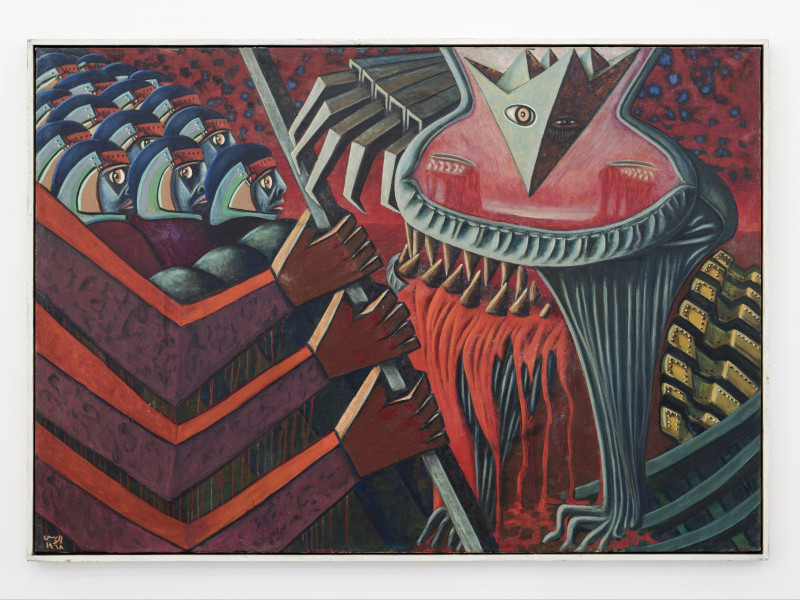

Biography
Practicing in several media, including tapestry, sculpture and painting, Aref El Rayess developed an interest in abstraction. He was also influenced by his travels across West Africa, which inspired him to incorporate folkloric and mystic motifs into his work.
A self-taught artist, El Rayess began painting at the age of 11. In 1948, his first exhibition was held in Beirut at the UNESCO building with the support of journalist Arlette Levy, artist Georges Cyr, art critic Victor Hakim and Head of the French Institute of Archaeology, Henry Seyrig.
From 1948 to 1957, El Rayess travelled between Senegal and Paris, where he studied as a free student at the Paris National School of Fine Arts and La Grande Chaumière Academy, and worked and trained in the studios of André Lhote, Fernand Léger, Marcelle Marso and Ossip Zadkine.
Upon his return to Lebanon in 1957, he worked in a theatre group and opened an atelier of Aubusson tapestries for local people with Roger Caron. Two years later, after an exhibition at the Italian Cultural Centre, El Rayess was offered a scholarship to study in Italy, where he spent four productive years between Florence and Rome. In 1963, he was commissioned by the Lebanese government to produce two sculptures that would represent Lebanon at the New York World Fair.
He returned to Lebanon in 1967, the country marked by the Arab defeat in the War of June 1967. He was a founding member of the Fine Arts Department at the Lebanese University where he taught, and a member of the independent cultural initiative Dar el Fan with his close friend Janine Rubeiz. From that time, El Rayess organised, attended and participated in conferences and exhibitions on politics and arts in the Arab world. In 1972, he published a manifesto titled With Whom and Against Whom. In 1975, he was invited to Algeria where he produced a series of drawings depicting the Lebanese civil war, published as the book The Road to Peace.
His work has been the subject of several solo exhibitions at Sfeir-Semler Gallery, Beirut (2021); Espace SD, Beirut (2002); UNESCO, Beirut (2000), French Cultural Centre, Beirut (1998); French Cultural Centre, Beirut (1995); Galerie Racim, UNAP, Alger, Algeria (1976); Arab Cultural Centre, Syria (1974); Damascus National Museum (1969); Galeria d'Arte del Palazzo delle Esposizioni, Italy (1961), among others.
He also participated in group exhibitions at Sursock Museum, Beirut (2003); International Symposium of Sculpture, Aley (2000); The International Art Exhibition in Solidarity with Palestine (1978); Lebanese Council, Tubingen, Germany (1974); Centro d'Arte La Baracaccia, Italy (1972); International Exhibition of Sculpture, Musee Rodin, Paris (1966); and 2nd Biennale of Alexandria, Egypt (1957–1958), among others.
His works can be found in the public collections of Sursock Museum, Beirut; Barjeel Art Foundation, Sharjah; Saradar Collection, Beirut; Lebanese Ministry of Culture, Beirut; UNESCO, Paris; and Musee Public National des Beaux-Arts, Alger, Algeria.
He was the recipient of many awards, including Prize of Sculpture and Painting, Salon d'Automne, Sursock Museum, Beirut (1965–66); 1st Prize of Sculpture, Lebanese Ministry of Public Works (1964); and Prize of UNESCO (1957). He received a Rockfeller Grant and spent two years in the US and Mexico.
After the civil war in Lebanon, he moved to Jeddah and received further commissions from the Saudi government, including a 27-metre-high sculpture for Palestine Square, Jeddah. He stayed in Jeddah until 1987 and returned to Lebanon in 1992. He lived between London and Lebanon, until he passed away in 2005 in Aley.
Related Content

Aref El Rayess
More than five decades of work by the prolific Lebanese artist Aref El Rayess (1928 – 2005) is presented in the artist’s first major institutional exhibition to date.
